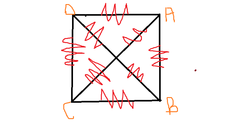An electricity and magnetism problem by Gajender Singh
 The equivalent resistance b/w
The equivalent resistance b/w
i) A and C= p
ii)B and D = q
Find p+q
All the resistance is equal to 1
The answer is 1.33.
This section requires Javascript.
You are seeing this because something didn't load right. We suggest you, (a) try
refreshing the page, (b) enabling javascript if it is disabled on your browser and,
finally, (c)
loading the
non-javascript version of this page
. We're sorry about the hassle.
Since from any corner , circuit is symmetric. Hence i/3 current flows in each branch. Apply Kirchhoff law in triangle ABC. we get 2i/3=i*R where R is net resistance b/w A and C. Again, Circuit is symmetric hence resistance b/w b and d is equal to resistance between a and c. Hence, net resistance is 4/3